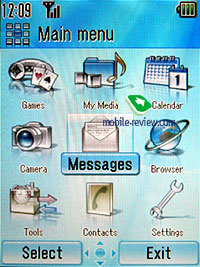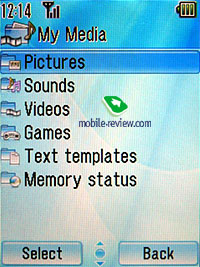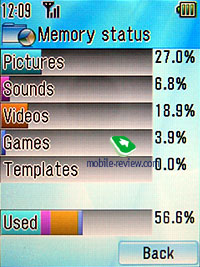Review GSM phone Panasonic VS3
Package:
Handset
Battery
Charger
Headset
Interchangeable panels
Key for installing panels
Manual
For the year 2005 the company has planned the launch of several series of phone on the Russian market. And they first were introduced at Expocomm 2005. Despite the variety of the handsets, they accurately divide into two classes. The Sc and A series phones have the resolution of 128x128 pixels and support 65K colours. The MX, SA and VS series have big displays (2.2" - 2.5") with the resolution of 320x240 pixels and support 16 million colours. In this parameter the phones are unique - none of the vendors provides such solutions today.

The VS series reflects a modern tendency towards reducing the body thickness (Slim) and includes three models. Panasonic VS3 described in the review takes an intermediate position in the line. The absence of Bluetooth and external screen makes the difference from the elder fellow VS7. The VS2 has no interchangeable panels. In the rest the models are equal.
Even the first glance on the model with the screen on gives away eminent Japanese, despite it is made in Czechia and is supplied with a "made in China" battery. This practice is now customary. Here we deal with an engineer sample, which is proved with the inscription under the battery cover.
Design
The handset has a book-like design, which is taking into consideration European notion of design. It looks like almost a rectilinear rectangle with the side ratio of 2x1 and dimensions of 96x46 mm with the height of 17.6 mm.

The front panel of the phone is made of a grey-dotted white plastic. At first look this solution represents nothing interesting, however, the presence of interchangeable panels will considerably transfigure the appearance. I'd like to note that such a geometrically flat front surface makes it possible to stick various films with pictures. The extreme case is not just plain pictures, but holographic and stereoscopic images. So, the model is ideal for styling. You can change the appearance beyond recognition applying your imagination and taste. Nickel-plated screws serve as decoration elements as well, which fasten the panel. A camera block is placed on the top of the front panel on a projecting plastic insertion, it consists of an objective and a mirror placed under for selfshooting. The objective having an exterior rod for switching a macromode will instantly draw your attention (you'll see it on the following photos). To tell the truth, I meet such a solution for the first time. Setting the objective to the macromode allows getting sharp photos from the distance of 4-5 cm. At the very place where the projection joins the panel you see a light diode serving for extra light indication. At charging, receiving a message or performing any other activity it blinks with various colours.






The left side surface features a charger block, headset and USB to connect to a PC. The block is covered with a rubber insertion with special signs on the front. The rubber shutter is fixed with a clasp, and you need to turn it up for cable connection. Since the clasp is absent on the other side, at long turn up (while charging for instance) the shutter fits the compartment hermetically no longer due to the permanent deformation. The headset connector is unordinary and suits only own headsets. And this very side features the button for automatic opening mechanism. That is comfortable, since a single pressure is necessary for opening the phone.

The right facet features an IrDA gap, a shutter/dictaphone button and two volume buttons for control during a conversation.
The right corner of the top facet holds a strap hole. And a steel-coloured back panel is present. It features a loudspeaker gap and a hollow for external antenna closed with a rubber shutter.
At opening the battery cover is easily moved down. A removable 830 mAh Li-Ion battery is under it. It lasted about three and a half days in case of average talk time reaching 15 minutes a day and sending/receiving 10-15 SMS. Then it required recharging. While testing we had the screen on, and then the battery lasted for three hours approximately, which is rather less than the passport says.


The SIM-card disposition is rather unusual - the slot is on the top of the battery compartment and features a picture. The bottom of the battery compartment holds an idle connector closed with a plastic insertion. We think in other models it will serve for memory cards. Thus, this hardware platform allows realizing other solutions.
The top inner panel features a 2.2" display supporting 320x240 pixels resolution. It shows 24-bit colour (16 million colours). Based on a TFT matrix, it almost has no equal ones in the picture quality. High resolution and small dot size make the image extremely sharp. However, the screen considerably fades in the sun, but still texts can be made out. Small view angle is a real drawback. Deflecting the screen for an angle of less than 30 degrees in vertical, you already can't see the picture. That is especially noticeable at comparison with Nokia N90, which also stands out for high resolution.

The bottom panel features a keyblock in a classical design with no contrivances. The top of the panel holds soft-keys, a call button and a cancel one. Between them a round 4D joystick with a confirmation button in the center. All the control elements are distanced well, and thus accidental pressures are almost excluded. The number keys are oval, large even for a big palm and have equal size. But their surface merges with the main surface, thus making it harder to enter data blindly. The only projecting button is "5". Slightly bend inwards it has a projecting point, which slightly eases navigation. The button motion is little and resilient. A typical click accompanies the pressure even at the sound off. You can program the settings for these joystick buttons for fast access to various phone functions. The keypad backlighting is even, pale-green. The font on the keys is seen very well in the dark.


The bottom panel features a microphone, a LED indicator of charge, and a projecting plastic insertion acting as a shock-absorber for the upper panel at fast closure.
Assembly quality
We noticed a slight horizontal backlash of the top part in the test sample we received. No other complaints of the quality rise. The plastic turned out qualitative, the panels make no creack, and the fonts on the keys are well-drawn. Since this engineer software version featured various incorrectnesses in translation, further I will cite English titles for menu items and settings.
Menu
The main menu is a typical 3x3 matrix of icons. Each one casts shadow and is accompanied with a pop-up tip. When pointing with a cursor, it increases its size. And fast navigation using number keys is possible.

Games. This menu item features Java-games, settings and an information bar. Two games are preinstalled, the first one is a famous Sonic hedgehog, known by old 8-bit consoles, and Football. Access to the network is present among game options; it serves for adjusting online connections. Among the settings is volume adjustment, control of background backlighting, setting the priority for an application, turning vibra on, reset of all settings and setting profiles for WAP-connections (15 possible). This item features no information of the memory available.

My Media represents a kind of a gallery in Nokia's phones and consists of the following sections:

Pictures contains photos shot by the integrated camera and received from the outside, as well as plain pictures. Camera functions are accessible from this very item.

Sounds contains preset and saved sound files and m4a ones, which are animated images with a sound track. Formats supported are mid, mmf, amr and mp3. When a sound files is played back, an animated headband runs. A dictaphone capable of up to 3 minutes of records is held in this very menu item. During a conversation it can be activated by pressing a side functional button. Middling quality and low volume.

Videos. Contains recorded video clips and allows recording a new one.
Games repeats a corresponding menu item.
Text templates allows creating templates for quick answer. Total number of such templates is limited with the free memory size. And ten templates are available from the beginning.
Memory status. This shows free and reserved memory percentage. Considers separately memory taken by pictures, sounds, video records, games and templates. About 25 MB of memory are available to a user, however, such representation in percentage is unusual and thus uncomfortable. Memory is distributed dynamically, with only limits on MMS. About 2 MB are given for them.

Calendar. The calendar is combined with an organizer and represents a very comfortable reference book for planned events. All the entries are divided into categories, and each has its own icons. The represented categories are Appointment, Business, Education, Public holyday, Meeting, Miscellaneous, Personal, Phone call, Hospital, Special occasion, Travel, Vacation, Birthday, Dinner, Driving, Exercise, Anniversary, Hobby, Date, Party, Shopping, School, Business trip, No category. Weekly and monthly data views are available. And fast switch to a necessary date is possible. About a hundred events can be saved into the memory. Extra settings allow specifying the start of the week and week-end. Sharp phones use the same organization. As for me, the calendar is one of the strongest points of the phone.




Camera. The integrated 1.3 MB camera allows photo and video shooting. Possible resolutions are 1280x1024, 640x480, 320x240, 160x120 and 240x320. Selecting the last resolution, you invert the picture by height. Similarly to Sharp GX-F200, when selecting the highest resolution, you can't use zoom. Image quality range includes extra clear, clear and normal. Night mode is provided for white balance presets. The camera allows a series of 15 frames. Then the resolution is forced to 320x240 pixels. Provided effects include sepia, white and black and negative. Autoshooting can be set for 5 and 10 seconds. You can select a shutter sound of 5 preset. It can't be off, however at the system sound set to the minimal volume it is not heard at all. An option called "Available space" shows the number of possible photos with the selected resolution and depends on free memory.




We received good results using macromode. And in general, the camera proved best despite low resolution.
Night mode, city (jpg, 170 KB)
Night mode,
multishooting (zip, 56,5 KB)
Macro, Night mode (zip, 215 KB)
To gain the first skills in mobilography, you will find camera capabilities enough; however, the camera of Sony-Ericsson К750i is more interesting.
Video is recorded only in the resolution of 176x144 pixels. Hot keys for controlling the camera functions are provided in the "Help" section. Video clips are limited in size when sent via MMS - the record duration forms 10 seconds (usual mode allows about 1 minute). When recording video, you can apply the same effects like for photos. Digital zoom and brightness control do not work during shooting.
Messages. About 500 SMS can be saved into the phone's memory. Memory bank of 2 MB is reserved for MMS. Old messages can be saved in the archive. You can send SMS to several addresses, templates (graphical slimes and text templates) and counters are here. You can create concatenated messages up to 1530 characters in length, use T9 dictionary. Emotion icons, EMS and sending music and graphics are not supported. When you receive such messages, a note shines: "8-bit data". And the message doesn't open. However, when receiving usual text smiles, you have the external LED blinking with various colours. I'd like to add any incoming message is followed with a sound prompting in English. The message form is rather funny, and you can switch it off when necessary. This very menu item holds settings for sending SMS and voice mail.



Browser. A WAP 2.0 protocol is supported, it allows saving multimedia applications and opening images. This item repeats the settings for access profiles. Security settings are kept here as well. However, no integrated e-mail client is provided.

Tools. Totally five alarm clocks are present, each allows adjusting once, daily and weekly work mode. Personally a melody and a call volume are set, as well as a picture shown at a call and backlighting. When selecting a backlighting mode, you have the LED's colour and blinking frequency changed.


Appoint - the indicator blinks with red
At ease - the indicator blinks with lilac blue
Get up - the indicator blinks with yellow
Happy - the indicator blinks with yellowish red
This very item contains a "Sound recorder", which repeats menu item from "My Media", and Calculator. The last one represents nothing interesting but four arithmetic operations, not more.


Contacts. The phonebook is accounted for 500 users. And each phone card contains several positions. Fields like "First name" and "Last name" can contain up to 18 characters, which are displayed all. Cyrillic characters are correctly supported. All the entries are viewed fully. While entering texts, you can switch the languages fast. Into the phone card you can enter mobile and home numbers, work phone and three e-mail addresses, birthday and postal address, and finally a note of 32 characters. For each addressee you can set personal call melody and message alert, select backlighting colour (available ones are red, blue, green, yellow, turquoise, and violet), a picture and a group. Total number of groups reaches 21. They are indexed from the beginning, and they can be reindexed. By default "out of group is set".


Fast dial for eight numbers is provided (buttons 2-9). Extra functions are synchronization, data output by name or surname, and by the way, entries in English are provided first. You can copy all the data from the phone to the SIM card or back by one touch, check memory status. Operator service phones are given in a separate item.
Call list is hidden in this item, it contains three lists, and namely "Dialed numbers", "Answered calls" and "Missed calls". The log is very good. I failed determining its maximum size. After two weeks of use, the log contained notes on all the calls, number of which exceeded fifty in each category. Each entry specifies data on time and date of a call with a call type. Extra graphical information like an icon with an arrow follows each entry. Incoming calls are marked with a green arrow, outgoing - blue, missed calls are red.


Settings. The last menu item contains settings. Here are traditional phone settings like profiles, language, time and date, backlighting control, button adjustment, general reset. Screen settings allow changing menu icons, control brightness, backlighting time, installing an operator's logo. Numerous sound settings, call functions including redirection and voice mail. "Connectivity" marks network settings. This item switches on IrDA realized partly. It makes mistakes. You can't send a Java-middlet to the phone and mp3 files. At the same time sending data (contacts, multimedia files) from the phone via IrDA caused no problems. However, the phone failed opening vCards sent from Nokia 6600 as SMS. That seems the matter is this engineer software version. By the moment of the official release these drawbacks should have been corrected.
General impressions and conclusions
The connection quality is good. The volume is enough for a conversation in a very noisy place. The phone resembles Samsung ones in the quality of sound, which is much superior to the previous Nokia's models. However, the vibracall is very weak, almost indistinguishable - the thin body prevented from placing a powerful vibra.
Also I was disappointed at founding no integrated mail client.
For a low-end phone that is not bad. And surely has no rivals in the screen quality. The bright LED adds a very spectacular appearance. Perfect screen, loud and clear sound in loudspeakers are evident advantages of the model. The design of the handset is universal and will suit both men and women. It will gather masses of worshipers at reasonable price policy.
The launch is planned for the 3Q 2005.
Victor Dashkevich (v.dashkevich@gmail.com)
Translated by Maria Mitina (maria.mitina@mobile-review.com)
Published — 10 September 2005
Have something to add?! Write us... eldar@mobile-review.com
|







































